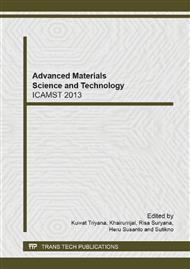p.502
p.506
p.510
p.517
p.521
p.525
p.532
p.537
p.541
Ground Shear Strain and Rate of Erosion in the Coastal Area of North Bengkulu, Indonesia
Abstract:
North Bengkulu district has an area prone to earthquakes, because this area is very closed to the Sumatra subduction zone to the Eurasian tectonic plate. Coastal area in this region is experiencing with the very fast erosion. This is thought to have relation with earthquake-prone zones. This study aims to find the relationship between Ground Shear Strain (GSS) and rate of erosion in the coastal area of North Bengkulu. The data of coastal erosion rate was obtained by overlaying shoreline in 1947 and 2012. The GSS can be obtained by multiplying Seismic Vulnerability Index (SVI) and Peak Ground Acceleration (PGA) values around the shoreline. Seismic Vulnerability Index was obtained by processing microseismic data acquired using three component in short period of seismometers. The PGA was obtained from the historical earthquake and calculated by using Fukushima-Tanaka equation. The results show that the value of GSS varies between 0.0001 to 0.0055, and the SVI values is ranging from 1.2 to 16.1. In addition, we estimated that PGA value is 92 to 120 and the rate of erosion between 3.6 up to 5.8 m/yr. GSS value for each type of coastal is 0.00046 for the fine sandy beach flat, 0.0043 for flat coastal muddy, 0.0001 for flat rocky beaches, 0.0006 for sandy beaches to rugged, 0.0003 for steep rocky lava beach, 0.0014 for steep rocky coast of for clay, 0.0011 for bertufa steep sandy beach stones, and 0.0014 for the steep rocky shore tuffaceous clay. It is found that the GSS value depends on the type of coastal. In this case, flat coastal muddy show highest effect on the GSS. Both SVI and GSS can be estimated to be a quadratic relation to the erosion rate.
Info:
Periodical:
Pages:
521-524
Citation:
Online since:
February 2014
Price:
Сopyright:
© 2014 Trans Tech Publications Ltd. All Rights Reserved
Share:
Citation:


